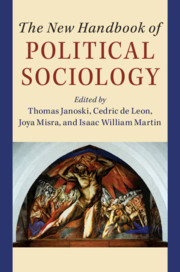Book contents
- The New Handbook of Political Sociology
- The New Handbook of Political Sociology
- Copyright page
- Dedication
- Contents
- Tables
- Figures
- Contributors
- Acknowledgments
- Introduction
- I Theories of Political Sociology
- II Media Explosion, Knowledge as Power, and Demographic Reversals
- 10 “Old” Media, “New” Media, Hybrid Media, and the Changing Character of Political Participation
- 11 The Sociology of Official Information Gathering
- 12 The Dark and Light Sides of Big Data
- 13 States, Parties, and Expertise
- 14 Toward a Political Sociology of Demography
- III The State and Its Political Organizations
- IV Civil Society: The Roots and Processes of Political Action
- V Established and New State Policies and Innovations
- VI Globalization and New and Bigger Sources of Power and Resistance
- Index
- References
11 - The Sociology of Official Information Gathering
Enumeration, Influence, Reactivity, and Power of States and Societies
from II - Media Explosion, Knowledge as Power, and Demographic Reversals
Published online by Cambridge University Press: 22 February 2020
- The New Handbook of Political Sociology
- The New Handbook of Political Sociology
- Copyright page
- Dedication
- Contents
- Tables
- Figures
- Contributors
- Acknowledgments
- Introduction
- I Theories of Political Sociology
- II Media Explosion, Knowledge as Power, and Demographic Reversals
- 10 “Old” Media, “New” Media, Hybrid Media, and the Changing Character of Political Participation
- 11 The Sociology of Official Information Gathering
- 12 The Dark and Light Sides of Big Data
- 13 States, Parties, and Expertise
- 14 Toward a Political Sociology of Demography
- III The State and Its Political Organizations
- IV Civil Society: The Roots and Processes of Political Action
- V Established and New State Policies and Innovations
- VI Globalization and New and Bigger Sources of Power and Resistance
- Index
- References
Summary
The government collects a barrage of information through censuses, registration, licenses, permits, and geographical information, so official information is a ubiquitous part of contemporary life. The sociology of official statistics analyzes this activity (Starr 1987: 7). The overall thrust of this work shows that official information gathering is socially constructed, that is, it is influenced by social and historical conditions, and it influences the reality that it supposedly describes.
Keywords
- Type
- Chapter
- Information
- The New Handbook of Political Sociology , pp. 290 - 320Publisher: Cambridge University PressPrint publication year: 2020
References
- 1
- Cited by

